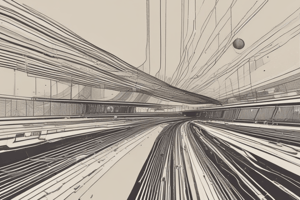Podcast
Questions and Answers
What does a distance-time graph for free fall look like?
What does a distance-time graph for free fall look like?
- Straight line
- Sinusoidal curve
- Exponential curve
- Parabola (correct)
How does a distance-time graph of an object with constant acceleration appear?
How does a distance-time graph of an object with constant acceleration appear?
- Sine wave
- Parabola (correct)
- Hyperbola
- Straight line
What is the characteristic shape of a distance-time graph for an object initially at rest and then moving with constant velocity?
What is the characteristic shape of a distance-time graph for an object initially at rest and then moving with constant velocity?
- Sinusoidal curve
- Exponential curve
- Straight line (correct)
- Parabola
Flashcards are hidden until you start studying
Study Notes
Discovering Motion in a Straight Line with Distance-Time Graphs
When we contemplate the world around us, one fundamental concept that often catches our attention is motion. In this exploration, we'll delve into the fascinating world of motion in a straight line, with a particular focus on distance-time graphs.
Motion in a Straight Line: An Overview
A straight-line motion is defined as a trajectory that does not deviate from a forward or backward direction. In other words, the object is moving along a single axis, like the familiar horizontal and vertical lines. In this context, we're concerned with how distance and time interact to describe the characteristics of an object's motion.
Distance-Time Graphs
Distance-time graphs, also known as position-time graphs, are visual representations of the relationship between an object's distance and the time it takes to travel that distance. These graphs plot the distance along a specific axis (usually the y-axis) and time along another (usually the x-axis).

Figure 1: Distance-time graphs illustrating various motion patterns.
There are distinct patterns and characteristics revealed by distance-time graphs that can help us analyze motion. Let's examine these patterns:
-
Constant Velocity: A straight line on a distance-time graph indicates that an object is moving with a constant velocity. The slope of the line corresponds to the object's average velocity.
-
Acceleration: Changing velocity over time is referred to as acceleration. A graph that displays an object's acceleration will be curved, because the slope of the graph is changing (i.e., it's not a straight line).
-
Constant Acceleration: An object's acceleration may be constant, meaning it experiences the same change in velocity for each increment of time. A distance-time graph displaying constant acceleration will show a parabolic shape.
-
Free Fall: In the absence of air resistance, an object dropped from rest will experience constant downward acceleration due to gravity. A distance-time graph for free fall will look like a parabola.
-
Constant Velocity with Initially Resting Object: If an object is initially at rest and then begins moving with constant velocity, the distance-time graph will start at the origin and display a horizontal line.
-
Constant Acceleration with Initially Resting Object: If an object is initially at rest and then experiences constant acceleration, the distance-time graph will begin at the origin and display a curve that starts sloping upward.
Conclusion
Distance-time graphs are powerful tools for visualizing and analyzing motion. By examining the shape and characteristics of these graphs, we can deduce information about an object's velocity and acceleration. The patterns revealed allow us to better understand the underlying dynamics of motion, providing valuable insights into the complexities of our physical world.
Studying That Suits You
Use AI to generate personalized quizzes and flashcards to suit your learning preferences.




